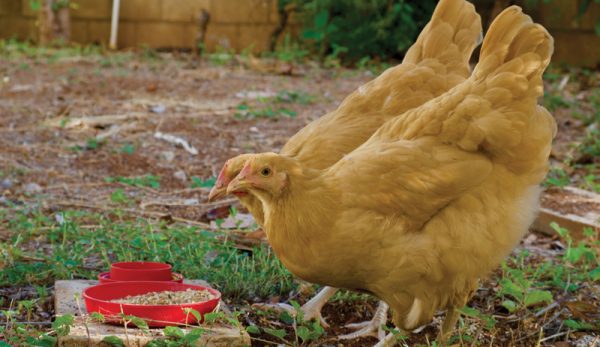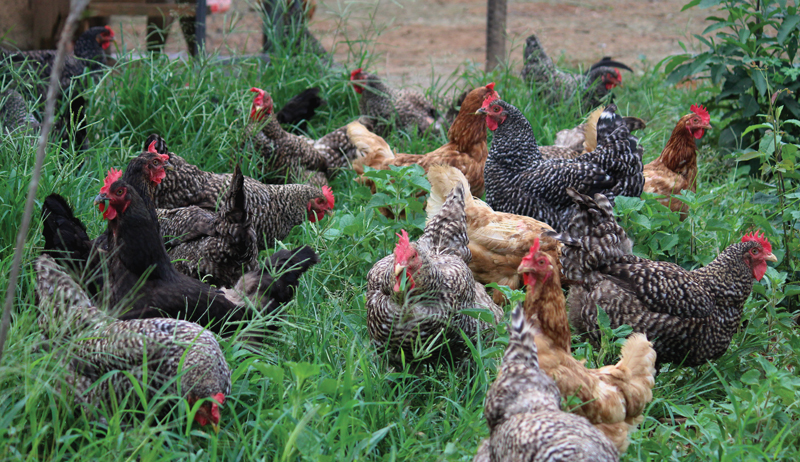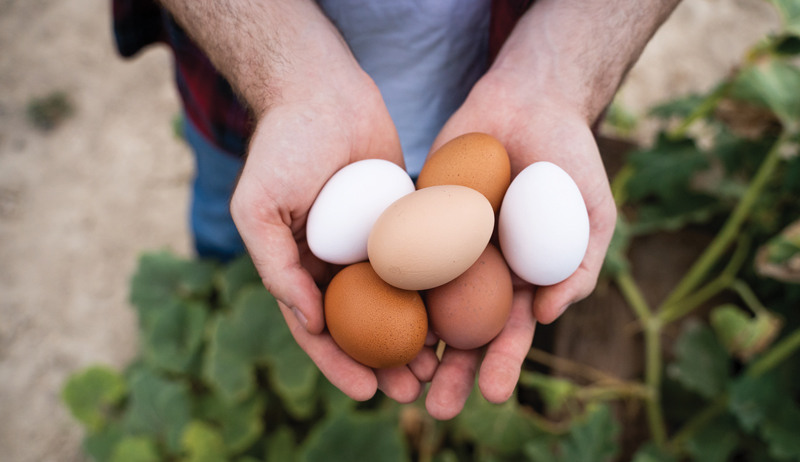
For many chicken-keepers, the most expensive part of our hobby is providing hens with good, wholesome feed. However, there are ways to do it without breaking the bank.
The most important thing is to buy a high-quality feed formulated for the kind of chickens you’re raising (layers, broilers, chicks, etc.). Complete feeds are necessary to get maximum production, including more eggs, faster growth for young broilers and healthier chicks. The trick is to augment commercial feed with less-costly “side dishes” that nourish your hens while making your bagged feed go further.
Be Precise & Shop Around
Try to buy exactly what your chickens need. (See “Complete Feeds at a Glance,” below.) One size does not fit all. For instance, starter feeds bagged for broilers is much too high in protein to safely feed future layers.
Read the labels, and stay within suggested parameters.
Look at the price tags, too. Name brand bagged feeds aren’t necessarily priced the same at every store. And ask if feed mills bag their own similar feeds. Many do and comparable house brands usually cost much less.
But again, read labels.
Sometimes low-cost house brands are bulked out with wheat bran and low-quality wheat-milling byproducts such as middlings, shorts, screenings and mill run. These aren’t good buys.
Keep in mind that major milling companies run sales and promotions well worth watching for. Subscribe to the mailings and e-newsletters of companies you like, add clip their coupons.
While you’re making a purchase, consider buying in bulk. Just don’t overdo it. Chicken feed that has been processed into pellets, crumbled, cracked or ground, including commercial bagged feeds, rapidly loses nutrition as it sits. Perhaps you can buy in bulk with a friend or two and split the order.
Store the bags in metal garbage cans, nonworking chest-type freezers, or food-grade 55-gallon drums with lids to protect them from predation by mice, rats and squirrels.
Grit & Oyster Shells
You won’t need to provide grit if you feed your hens nothing but commercial mash, pellets or crumbles. If you add anything else, you will. Chickens don’t have the means to chew their food since they don’t have teeth.
After being eaten, grit travels down to and lodges in a chicken’s gizzard where it helps grind coarse food into digestible paste. Free-range chickens pick up some grit naturally but probably not enough. Your best bet is to provide a container of grit so your chickens can help themselves as they need it.
There is a finely ground grit for chicks up to 8 weeks of age and larger grit made for full-fledged adults.
Grit is not the same as ground oyster shell. Oyster shell provides high-quality calcium to laying hens. Other classes of poultry don’t need it. Hens do.
Note: Never mix grit or oyster shell with your hens’ regular feed. It should be provided as a separate free-choice supplement.
Another great way to add calcium to laying hens’ diets is to save eggshells and give them back to the flock by placing finely crumbled, cooked pieces in a serve-yourself feeder. To do this, microwave them for 5 minutes on high, let cool and crush. You can also preheat your oven to 200 degrees Fahrenheit, spread the shells evenly on a baking sheet and bake them for 30 minutes.
Read more: Why feed oyster shell? Here’s a basic breakdown.
Get Scrappy
Fruit and vegetable scraps can be a fine addition to a commercial chicken-feed diet. Offer them in a separate feeder, or spread larger items on the floor of the coop or a dry place outdoors.
Other things you can feed include bakery byproducts, pasta, cereal, chips, bird seed, garden clippings, cooked meat and fish, and tofu. A great source of healthy scraps is whole, uncut pumpkins left unsold after Halloween. To feed them, break them in pieces so your hens can eat right from the rind.
A bonus: They stay good for months in cool storage.
Don’t feed moldy or rotten scraps to your chicken. Mushy fresh fruit is an exception. Feed only as much as your chickens clean up in an hour or so. Leaving scraps to rot attracts flies, mice and wildlife such as raccoons and opossums.
Slice or break open things with thick skins such as melons and winter squashes.
Do not feed hens any of the following:
- raw potatoes, potato skins or potato vines from the garden
- green tomatoes or tomato vines
- immature eggplant or eggplant vines
- dry beans or peas
- uncooked rice
- stone fruit without the pips removed
- onions
- raw eggs
- mushrooms
- rhubarb stems or leaves
- citrus fruit
- sugary foods such as candy and chocolate
- highly processed foods and excessively salty leftovers
- any part of an avocado
Feeding asparagus can make your eggs taste funny, so feed it in small quantities if at all.
You can also grow a chicken garden for your birds. Some things to consider include sunflowers, kale, cabbage, lettuces of all kinds, pumpkins, squash and mangels.
Also give your chickens nourishing garden weeds such as plantain, dandelions, chickweed and lamb’s-quarter. Garden invaders—potato bugs, cabbage worms, slugs, etc.—make great snacks for your birds. Speaking of bugs …
Build Bug Bowls
The best possible way to augment your chickens’ diet is to let them free-range and pick their own greens and insects. If you live where ticks are a problem, chickens love ticks!
If you don’t, consider buying or raising nourishing mealworms to feed your hens. It’s easier than you think.
Cut a hole in the top of a small plastic bin with a tight-fitting lid. Duct tape a piece of screen over the hole to allow airflow without allowing the mealworms to escape. Place 2 inches of oat bran or oatmeal in the bottom of the bin. Slice a potato in half and place it in the bin as a food sources.
Add mealworms. 200 to 400 is a good place to start.
You can purchase mealworms at bait shops or pet-supply stores or order them online. They’ll morph into small beetles and lay eggs that hatch into more mealworms.
Replace the potato once a week or sooner if it gets moldy. Feed the worms to your chickens several times a week, allowing five to 10 per chicken per feeding. Mix them with feed or scatter them in the litter on the floor of their coop so your girls can go crazy digging for them.
Feel Free to Ferment
A cost-free means of boosting nutrition is to ferment your chickens’ food. Fermentation creates healthful probiotics that aid in digestion, strengthen the immune system and multiply vitamin content.
You can ferment any feed, be it crumbles, pellets, scratch, seeds or whole grains.
According to the Permaculture Research Institute, to ferment chicken feed, soak it in chemical-free water overnight, and then place it in a bucket with an optional bit of dry bran. Mix it up, and cover with water.
The feed needs to stay submerged. As it soaks up water, add more.
After a couple of days, the mix will start to bubble and smell slightly sour but not unpleasant. It’s then ready to feed. Save a little of the cultured feed to start a new batch. It’s that easy.
As you fine-tune your feeding routine, be sure to feed sensibly. With layers, a three-feeder system works best, with commercial feed in one, ground oyster shell in another, and a third to dispense less-expensive but tasty and nutritious goodies such as whole grains, chopped garden vegetables or homemade mash.
You might think your hens will pig out on commercial feed, but in fact, they won’t. They’ll happily go for the tasty but inexpensive side offerings, too, while benefiting from the nutritional goodness of a complete feed.
Whatever you feed, minimize waste by using efficient feeders. Chickens are notoriously wasteful, but you can buy no-waste feeders or build your own using instructions found online.
Read more: Ferment your feed for better health.
Water, Water
Finally, keep in mind that chickens require 24/7 access to clean drinking water. Water controls the rate they digest food, their body temperature and how efficiently they eliminate waste. Hens also need a plentiful supply of water to lay eggs.
Chickens don’t drink large amounts of water at one time. They tend to sip a little water and do it often, which is why they need access to water at all times.
Supply enough waterers so your birds never run out. Make water more attractive in the summer by placing waterers in the shade and adding ice cubes or frozen water bottles as needed to keep water cool. Try heated waterers in the wintertime. Heated dog bowls are a good choice for smaller flocks.
Sidebar: Complete Feeds at a Glance
Although some feed mills offer one-size-fits-all, avoid these and purchased feed formulated for the purpose and age of your chickens.
Basic Feed Types Protein Level Age of Birds (weeks)
- Chick Starter (Layers) 20 to 22 percent 0 to 6 weeks
- Chick Starter (Broilers) 22 to 24 percent 0 to 8 weeks
- Pullet Grower 14 to 16 percent 6 to 20 weeks
- Broiler Grower/Finisher 16 to 18 percent 8 to 16 weeks (or sooner, if slaughtered at a younger age)
- Layer Feeds 15 to 18 percent 20 weeks and older
Chick starters come as very finely crumbled feeds formulated to support early chick growth and provide vitamins and minerals for development. They include added ingredients such as probiotics to support health. Broiler chicks require considerably more protein than do future layers. Some brands come in medicated and unmedicated varieties. Medicated feeds contain an anticoccidial drug called Amprollium, which protects chicks from coccidiosis, a common parasitic poultry disease.
Pullet growers are formulated for prelayers. They’re lower in protein and contain less calcium than layer feed. Broiler grower/finishers are lower in protein than broiler starter but are formulated for rapid growth.
Layer feeds contain a balance of protein, calcium, and additional vitamins and minerals to keep egg-producing hens healthy while encouraging abundant egg laying and the production of sturdy eggshells.
Grower, finisher and layer feeds come as mash (loose, finely ground feed roughly the texture of potting soil), crumbles (a coarser type of mash) or pellets.
Another type of bagged feed is scratch, a random mixture of grains such as whole or cracked corn, oats, sunflower seeds, wheat, barley, milo, millet and milling byproducts. They generally run about 8 to 10 percent protein and should be considered a treat instead of a complete feed.
This article originally appeared in the January/February 2021 issue of Chickens magazine.




